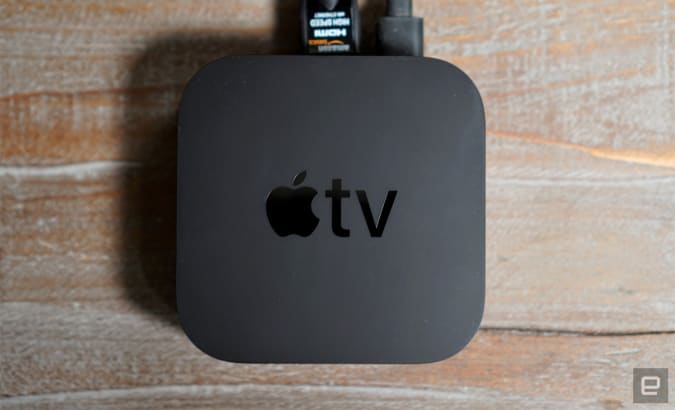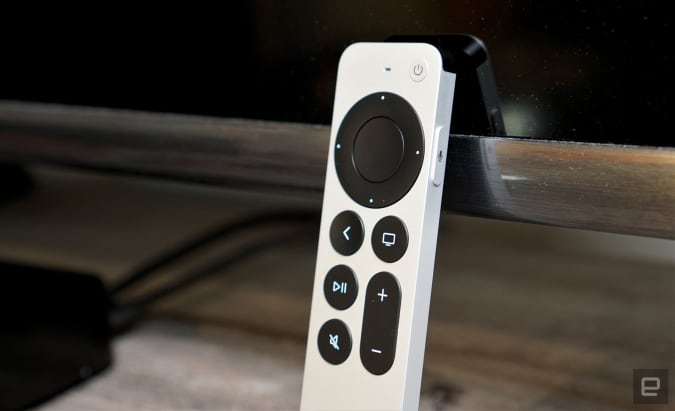
[ad_1]
Image Credit: Devindra Hardawar/Engadget
So, if you can’t tell, I really like the Siri Remote. But, overall, the new Apple TV 4K isn’t a dramatic departure from the 2017 model. Its A12 Bionic processor allows it to display Dolby Vision and HDR video at 60FPS, but that’s not an upgrade most people will notice. Aside from some videos in the Red Bull app, there’s simply not much high framerate Dolby Vision content out there. And the rare films that utilize that technology, like Ang Lee’s Gemini Man, aren’t available at their full framerate on iTunes.
Moving around the Apple TV interface and launching apps felt a bit quicker than the last model, but not noticeably so. Some of that zippiness could be due to its faster Wi-Fi 6 networking, but I didn’t see any major speed bumps while actually loading videos. There’s also the potential for the A12 Bionic to run games faster than the previous A10X Fusion chip, but I’ve yet to hear from any developers eager to tap into that new hardware. Since it supports HDMI 2.1, the Apple TV could technically hit 120Hz in the future as well. That could lead to smoother gameplay for some titles.
It’s worth noting that the A12 Bionic is itself a bit old. It originally appeared in the iPhone XS in 2018. So, let me reiterate: If you already have the last Apple TV 4K, there’s little need to get this new box.
For newcomers, though, the Apple TV interface is still pretty compelling. It’s functionally the same as Amazon and Roku’s — launching apps and choosing videos is pretty basic, after all — but there’s an extra layer of polish that I appreciate. Think of it like the difference between Mac OSX and Windows XP in the 2000’s. The Apple TV’s grid icons look slicker, and I appreciate being able to hop back into a show or movie via the TV app. Multitasking is something Roku still can’t do, whereas it’s easy to hop between different apps and streams on the Apple TV. You can even throw videos into a picture-in-picture window as you navigate other apps.

Devindra Hardawar/Engadget
Naturally, the Apple TV also makes plenty of sense for iPhone and iPad owners. Beyond AirPlay and screen mirroring, you can also use iOS alongside the Apple TV to type in text fields. That’s particularly useful if you’ve got long passwords, or if you store them on a password manager.
For the most part, streaming video on the Apple TV looks just as good as any other 4K/HDR streaming box. But Apple also takes a unique route to displaying high-dynamic range content: It forces your TV to always keep HDR on. That helps to reduce the annoying flicker that occurs whenever a TV switches between different dynamic range modes, but it could lead to some issues displaying older standard dynamic range content. On my TCL 8-series set, the Apple TV defaults to 4K Dolby Vision at 60Hz. I haven’t noticed any issues while watching older sitcoms like Cheers and Frasier, but it’s something many users have complained about over the years.
After plenty of complaints in 2017, Apple eventually offered the ability to automatically match the frame rate and dynamic range, instead of forcing HDR. But that doesn’t work for every app, unfortunately. For now, I’d consider that an issue to look out for, but it’s not necessarily a dealbreaker.
While you’d get more precise control of your video settings with a Roku Ultra, you’d also miss out on one of the Apple TV’s biggest assets: Siri. On iPhones and iPads, Apple’s virtual assistant sometimes has trouble keeping up with my commands. But on a more limited set-top box, where I just need to find something to watch, Siri ends up being far more useful than Roku or Amazon’s offerings. Searching for shows and movies takes just a few seconds, and in general, the Siri Remote does a great job of hearing what I’m trying to say. Siri can also help you find new things to watch, or you can ask her to play the latest episode of whatever you’re bingeing.

Devindra Hardawar/Engadget
You can also use the Apple TV as a HomeKit hub, allowing you to control things like smart lights when you’re away from home. Personally, that’s not something I’ve ended up using much, but I do love the ability to quickly view my Arlo security camera feeds. If I ask Siri to “show me the basement door,” it gives me a clear view of that camera within seconds. Those videos pop up in PiP windows at first, but you can also maximize them to fill your TV screen. The new Apple TV also supports the Thread smart home standard, like the HomePod Mini, which lets you create a mesh IoT network with other devices. That’s more about future-proofing though, as there aren’t many Thread-enabled products yet.
At $179 for the 32GB model, and $199 for the 64GB version, the Apple TV still feels like a tough sell for many. That’s especially true when you consider that the Roku Ultra, that company’s most powerful device, typically costs $100 (and it’s on sale for $70 at the time of this review!). But there’s a reason I keep coming back: It’s easy to use, and there are a ton of benefits for iOS users. At the very least, I no longer have to make any excuses for the remote.
All products recommended by Engadget are selected by our editorial team, independent of our parent company. Some of our stories include affiliate links. If you buy something through one of these links, we may earn an affiliate commission.
[ad_2]
Source link






